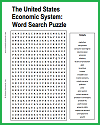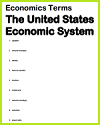The United States Economic System |
 |
 |
|||||||||
| U.S. Economic System Word Search Puzzle | U.S. Economic System Vocabulary Terms Sheet |
|
The United States has a mixed-market economic system, often characterized as a capitalist or market economy. This system combines elements of both a market-driven economy and government intervention. Here are the key features of the economic system in the United States. Private Ownership: In the United States, a significant portion of resources, businesses, and property is privately owned by individuals, corporations, and other non-governmental entities. Private ownership is thought to encourage entrepreneurship and individual initiative. Market Allocation: The allocation of goods and services is primarily determined by supply and demand in competitive markets. Prices play a central role in coordinating economic activities, guiding production, and influencing consumer choices. Profit Motive: The pursuit of profit is a fundamental driver of economic activity. Individuals and businesses make decisions with the aim of maximizing their financial returns. Competition: The U.S. economy encourages competition among businesses. It is widely believed that competition fosters innovation, efficiency, and consumer choice as firms strive to gain market share. Limited Government Intervention: While the government plays a role in regulating economic activities to ensure fairness and protect consumers, the degree of government intervention is generally lower than in planned economies. The U.S. government enforces property rights, enacts antitrust laws, and establishes regulations for various industries. Particularly in recent decades, government at the local, state, and federal levels, has offered financial incentives to businesses to relocate to or to remain in their jurisdictions, and for other reasons; this has led to widespread complaints regarding "corporate handouts." Individual Freedom: The U.S. economic system places a strong emphasis on individual freedom and economic liberty. People have the freedom to own property, start businesses, and engage in economic activities with limited government interference. However, especially given the widening economic inequality within the United States, this freedom is merely theoretical for much of the American population. Fiscal Policy: The U.S. government uses fiscal policy to influence economic conditions through decisions related to taxation, spending, and borrowing. Fiscal policies are designed to address various economic objectives, including economic growth and stability. Monetary Policy: The U.S. central bank, the Federal Reserve, manages monetary policy by controlling the money supply, regulating interest rates, and monitoring financial stability. It aims to achieve goals such as price stability and full employment. Financial Markets: The United States has highly developed financial markets, including stock exchanges, bond markets, and commodity markets. These markets facilitate the allocation of capital and investments. Labor Market: The labor market is characterized by a high degree of labor mobility, with individuals able to choose their occupations and change jobs relatively freely. Labor laws exist to protect workers' rights. Welfare and Social Safety Nets: The U.S. government provides various social safety net programs, including Social Security, Medicare, Medicaid, and unemployment benefits, to support individuals and families in need. These social safety net programs are among the lowest in the industrialized world, however, and increased globalization has left many Americans living precariously. Regulation: Certain industries, such as healthcare, banking, and transportation, are subject to substantial government regulation to ensure public safety, fair competition, and consumer protection. International Trade: The United States is heavily engaged in international trade, with a significant portion of its GDP dependent on exports and imports. Trade agreements, tariffs, and trade policies play a crucial role in shaping the U.S. economy's global interactions. It's important to bear in mind that while the United States has a predominantly market-driven economic system, it also incorporates elements of government intervention and regulation to address various economic and social objectives. This mixed-market approach aims to balance individual freedom and economic efficiency with the need for social safety nets and regulatory safeguards. |






